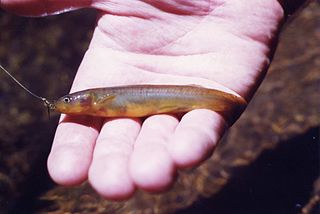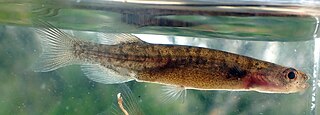
The Galaxiidae are a family of mostly small freshwater fish in the Southern Hemisphere. The majority live in Southern Australia or New Zealand, but some are found in South Africa, southern South America, Lord Howe Island, New Caledonia, and the Falkland Islands. One galaxiid species, the common galaxias, is probably the most widely naturally distributed freshwater fish in the Southern Hemisphere. They are coolwater species, found in temperate latitudes, with only one species known from subtropical habitats. Many specialise in living in cold, high-altitude upland rivers, streams, and lakes.

The climbing galaxias or kōaro is a fish of the family Galaxiidae found in Australia, New Zealand, and nearby islands. The name climbing galaxias is used in Australia, and koaro or kōaro in New Zealand. Further vernacular names include short-finned galaxias, broad-finned galaxias, Cox's mountain galaxias, and Pieman galaxias.

The Chatham mudfish, formerly known as the Chathams galaxias, is a galaxiid fish endemic to two small, peaty lakes in southern Chatham Island, New Zealand.

The Canterbury mudfish, also known as the kowaro, is found only on the Canterbury Plains in New Zealand. Like other Neochanna species, it is a small, tubular and flexible fish which lacks scales. They are able to survive out of water in damp refuges if its wetland habitat dries out periodically over summer.

The waikaka or black mudfish is a fish of the family Galaxiidae, found only in swamps and wetlands in the northern half of the North Island of New Zealand, from Kaitaia in the north to the Mokau River in the south.

The brown mudfish is a galaxiid endemic to New Zealand. The species is found in wetlands in the southwest of the North Island and the northern half of the west coast of the South Island. It commonly grows to 100–130 mm in length, and it can live to at least 7 years. They are named for their brown color.

Neochanna is a genus of galaxiid fishes, commonly known as mudfish, which are native to New Zealand and south-eastern Australia.

The banded kōkopu is a galaxiid of the genus Galaxias, found only in New Zealand, including the Chatham and Stewart / Rakiura islands. It commonly grows to 20–25 cm, but has been recorded growing to around 30 cm. Juvenile banded kōkopu are good climbers and can climb up waterfalls and other vertical surfaces by moving into the splash zone and wriggling up the surface, using the water surface tension and their large downturned fins for grip.

Eldon's galaxias is an endangered galaxiid fish endemic to New Zealand. One of several fishes in the genus Galaxias found in Central Otago, it has a very small home range and is at risk of being driven to extinction by trout introduced for recreational fishing.

Gollum galaxias is a galaxiid of the genus Galaxias, found only in southern temperate regions in New Zealand. The species is widespread in rivers throughout the Southland Plains as well as the Von River and Nevis River tributaries of the Clutha River The species is found on Stewart Island / Rakiura, and throughout the Catlins.

Galaxias is a genus of small freshwater fish in the family Galaxiidae, and are frequently referred to as the galaxiids. These highly adaptable fish are typically found at temperate latitudes across the Southern Hemisphere.

The Tasmanian whitebait, also known as the Australian whitebait or Derwent whitebait, is a semi-anadromous ray-finned fish of the family Galaxiidae, found only in Tasmania and southern Victoria, Australia. It is the only species in the genus Lovettia.
The western galaxias, also called the western minnow, is a species of fish in the genus Galaxias of small, Southern Hemisphere freshwater fish of the family Galaxiidae. It is endemic to southwestern Australia.

The Golden galaxias is an endangered species of landlocked galaxiid fish belonging to the genus Galaxias. It is endemic to Lakes Crescent, Sorell, and their associated waterways located in central Tasmania, Australia.
Galaxias arcanus, the riffle galaxias, is a galaxiid of the genus Galaxias, a member of the Mountain Galaxias species complex group of freshwater fish, found in Australia.
Galaxias gunaikurnai, the Shaw galaxias, is a galaxiid of the genus Galaxias, a member of the Mountain galaxias species complex group of freshwater fish, found in Australia.
Galaxias mcdowalli, McDowall's galaxias, is a galaxiid of the genus Galaxias, a member of the Mountain Galaxias species complex group of freshwater fish, found in Australia.
Galaxias mungadhan, the Dargo galaxias, is a galaxiid of the genus Galaxias, a member of the Mountain Galaxias species complex group of freshwater fish, found in Victoria, Australia.
Galaxias oliros, the obscure galaxias, is a galaxiid of the genus Galaxias, a member of the Mountain Galaxias species complex group of freshwater fish, found in Australia.

Galaxias supremus, commonly known as the Kosciuszko galaxias, is a galaxiid of the genus Galaxias, a member of the Mountain galaxias species complex group of freshwater fish, found in Australia.














